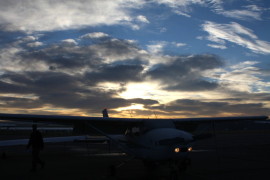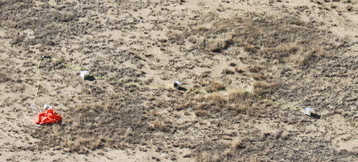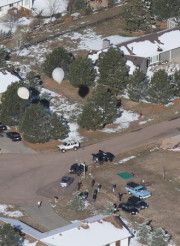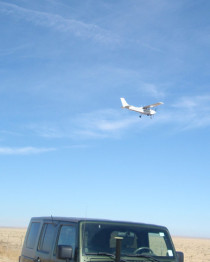Air Support ConOps
The EDGE team is fortunate to have a licensed pilot on the team, and we take advantage of this opportunity by having air support present for the launch and recovery phases of our flights. On the EDGE3 mission, this was particularly helpful, as the payload landed nearly two miles away from the nearest road, and in a slight depression that reflected all of the tracking signals up and away from the chase teams. After we estimated where we thought the payload was, we called in the airborne team; they received the exact landing location and verified that the payload was recoverable prior to the ground teams making the long hike in.
In addition to assisting with the recovery effort, the airborne team provides a third dimension of situational awareness to our launch area, and captures a unique perspective on what's going on during the launch phase.
We have three people in the air for each flight: a pilot, a communications operator (responsible for communicating and coordinating with the ground teams), and a tracking operator (responsible for following the location of the balloon and communicating that to the other two). Additionally, our comms operator works airborne APRS tracking, and both the comms and tracking operators have cameras with them. Our pilot is only responsible for flying and landing safely.
Because we don't own an aircraft (we rent it from a local flying club), the airborne team's day starts fairly early, as indicated by the picture at the top of the page. As with the rest of the team, every attempt is made to schedule and coordinate the motion of the airborne team, but sometimes things happen - like having to de-ice the airplane prior to departure (a 30 minute delay). Generally speaking, though, we've found that it's possible to predict how long most of the parts of airborne operations will take and schedule accordingly. So, for your reference, here's the schedule that the EDGE airborne team follows, referenced to launch time:
- T-1:30:00 - Airborne team arrives at airport, begins tech integration and preflight
- T-0:45:00 - Tech integration and preflight complete
- T-0:35:00 - Phone call to launch site to confirm launch schedule
- T-0:30:00 - Departure towards launch site
- T-0:10:00 - Arrive overhead launch site
- T-0:05:00 - Confirm primary and backup tracking systems locked
- T-0:00:00 - Documents launch
- T+0:05:00 - Depart launch site for intermediate airport (along balloon flight path)
- T+1:15:00 - (Approx. burst) Depart intermediate airport for predicted landing site
- T+2:00:00 - (Approx.) Support ground recovery teams in location and retrieval of payload
- T+2:45:00 - (Approx.) Return to home base airport
So far, we've been very glad to have the extra altitude on our side during launch and recovery. Particularly in cases like the landing area for EDGE3, where ground teams are hampered by a lack of infrastructure, being able to put a receiver up several hundred feet helps tremendously. There are some things that we've learned in the process of integrating an aircraft into our conops that may be helpful to you:
Make your payload visible. A giant orange parachute, shiny payloads, anything you can do (within the bounds of legality and common sense) to make your payload more visible on the ground in any kind of terrain will make your airborne team more effective.
Don't count on the aircraft's electrical system - and check it before you plug something in. Some airplanes run 24V supplies to otherwise "normal" mobile power sockets.
As much as possible, integrate ground communications into the cockpit audio feed. Cockpits are noisy and aviation headsets aren't designed to let noise other than the aircraft radio/intercom into your ears.
We're thrilled to have air support for EDGE missions, and hope that you have the opportunity to do something similar. In addition to being very useful, it's just so cool!






